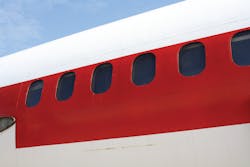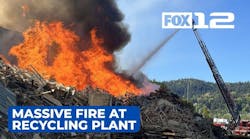The past two articles regarding aircraft rescue operations and structural fire departments – “Aircraft Rescue & Structural Fire Departments” in the November 2012 issue of Firehouse® Magazine and “Dangers to Responders at General-Aviation Accidents” (April 2013) – served as building blocks by focusing on emergencies involving light-aviation and general-aviation aircraft. Beginning with this article, we focus on emergency responses involving commercial aviation and how these incidents are going to differ from those involving smaller aircraft. Even though it is still an airplane crash, the response by structural firefighters will be different in many ways.
In the United States alone, there are approximately 28,500 commercial flights a day. That equates to about 9 million flights each year and about 732 million people flying in the skies over the country. Commercial aviation is still the safest mode of transportation per miles traveled. This is a positive for the airline industry, but with an aviation system that is expected to continue its growth at a rate of 3% to 5% a year for the next decade, the potential remains for accidents to occur.
An obvious reason why commercial aviation accidents are so different from light- and general-aviation accidents is that the casualty counts can be much greater than with a small aircraft or an executive-type aircraft. Another problem for emergency responders is not only casualties, but caring for the uninjured.
Types of impact
Many well-documented commercial crashes that have taken place over the past decades and survival factors usually come down to the type of impact. Destruction of an aircraft can depend on many factors, but the “attitude.” or angle at which an aircraft strikes the ground, will have a great deal to do with passenger survival. An aircraft that strikes the ground at an extreme angle will usually result in a high-fatality incident. These crash-site footprints can be relatively small and compact. Remaining pieces of the aircraft tend to be smaller and less identifiable. In many cases the recognizable parts of the aircraft will be the engine, tail section and landing gear. These parts are usually very dense or strong in their construction and sustain impact forces better.
Aircraft with the ability to touch down in a more “normal” landing configuration, if you will, may have a much more survivable outcome. This will vary greatly depending on what is on the ground and what the aircraft does or does not strike. These scenes will be the ones that will require the most fire, EMS and law enforcement intervention and will test the limits of emergency plans and services. Whether the accident is high or low impact, it can have a profound impact on emergency services and the community in general.
Aircraft construction
As the old saying goes, “little kids little problems, big kids big problems.” The same may be said of aircraft accidents. Basic construction practices that have been discussed in previous articles still hold true, but in bigger aircraft the parts and construction are more robust. The primary material is still aluminum panels placed over a skeleton called stringers (sometimes called longerons) and formers. This creates the fuselage or cabin. The wings, engines and landing gear are attached to that. The aircraft skin is usually only a few millimeters thick and that thickness can depend on the model of the aircraft and the skin’s location on the airframe.
On the inside of that thin aircraft skin is a small layer of insulation, some light and call button wiring and tubes for airflow and then a plastic panel for aesthetics and finish. Then windows, seats, control surfaces are added along with, in some cases hundreds if not thousands of miles of wiring, depending on the aircraft, and then made to fly. Aircraft are very complex, intricate machines and like has been said in previous articles, if you know how they go together they are easier to take apart.
Gaining entry
Any aircraft that flies high enough needs to be pressurized for passenger and crew survival. Rescuers must understand that making entry into an aircraft that has the ability to be pressurized is different from entering a non-pressurized aircraft.
All windows, doors and hatches in pressurized aircraft are “plug type.” That means internal pressure created from the inside to the outside of the aircraft helps holds these items in place and creates a seal. Therefore, depending on the model of aircraft, the door may have to actually move into the aircraft before it will swing out wards. Exit windows that are removable, in many cases, must go into the aircraft before being discarded out of the aircraft. All exits are required to be identified by a two-inch coloring that contrasts the main body of the aircraft. This makes the emergency escape area easily identifiable. In each case, “try before you pry” because these areas of the aircraft are very strong and may defeat extrication tools.
The windshield on the flight deck is very thick and difficult to cut. In some cases, the windshield is well over an inch thick. There are other dangers as well to responders from aircraft doors and windows. Everyone is familiar with premise of escape slides and how they work. If a responder opens a door that is “armed,” the slide could activate, resulting in injury or death. These slides deploy in a matter of seconds and once they start, they will not stop until fully inflated.
If there are survivors in the aircraft, use these slides to your advantage to help evacuate them. Then the slide can be deflated or removed for entry/exit ladder placement. In cases where the aircraft is sitting low to the ground, slides may be able to be used for entry by rescuers. Over-wing windows can be removed from the outside of an aircraft, but usually they must go inward before being removed. Over-wing exit doors can weigh between 30 and 50 pounds. If anyone is still in the aircraft and is ambulatory, and you make an opening in that aircraft, they will be coming out at you in a hurry.
Once everyone who can leave the aircraft has self-evacuated, then entry can be made by emergency responders. Use any normal opening or one created by crash impact forces before attempting to forcibly cut your way in. Forcing entry to an aircraft is difficult, time-consuming and dangerous. It often has to be done from an elevated platform of some type. If the aircraft has landed in a remote area or on uneven terrain, this talk will be even more difficult. Working from a ladder is difficult with power rescue tools or rescue saws.
If the skin of the aircraft must be cut with rescue saws, use the width of three windows to make your opening, if possible. This will provide a wider opening and will make it easier to move in equipment and evacuate the injured. You will make three or four cuts. Three cuts will create a “fold-down” or “fold-to-the-side” opening in that section of the fuselage. If the choice is made totally to remove the cut section, make your bottom cut first.
Windows on the side of the aircraft cabin are easy to remove and cut, but the windows in the cockpit are very thick and should not be cut.
Cabin doors
Aircraft cabin doors will open and move to the outside of the aircraft and then move forward, open in an slide up into the body of the aircraft or drop down to the ground. All doors have instructions on them on how to open them, but the instructions are usually stickers that may burn away if they are involved in fire.
Some aircraft have cabin entry doors have stairs attached to them. These doors usually have a doorsill height of less than seven feet and are not equipped with slides. These doors are very heavy and are usually equipped inertia reels or are counter-balanced to assist in their lowering to the ground. Some of these doors weigh more than 600 pounds. In the event of an accident the inertia reels could become dislodged and not support the weight of the door as intended. If the door is opened in this condition, it will fall freely to the ground. NEVER open a cabin door and stand beneath it.
Smoke travel
There are no fire stops on aircraft. Every aircraft has channels and openings for wiring and piping to run through it. These areas allow for fuel lines, hydraulic lines and wiring for flight-control surfaces and electric to pass through them, to name just a few of the many components. A smoke condition on an aircraft could come from a remote area on the aircraft from where it presents itself.
Above the ceilings in most aircraft it is one open space from the front to the rear. There may or may not be a void space in smaller-body aircraft, but larger aircraft may have a large void space that runs the length of the aircraft above the cabin ceiling.
When dealing with a fire on an aircraft, many conditions that found in structural firefighting may be present such a backdraft and flashover. Self-contained breathing apparatus (SCBA) must be worn at all times during any type of fire condition involving aircraft.
Whenever your fire department responds to an emergency involving aircraft, call for aircraft rescue and firefighting (ARFF) assets for assistance. The training that ARFF departments receive qualifies them as a valuable asset in assisting your department in the successful handling of an aircraft incident.
The next article in this series will discuss what you can expect in the event that an aircraft disaster occurs in your response area.






